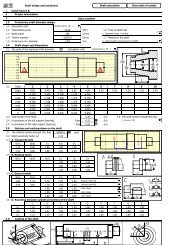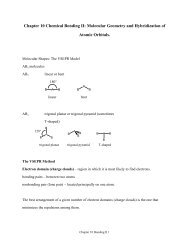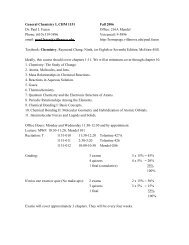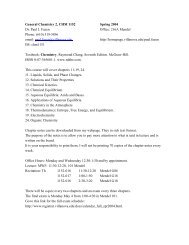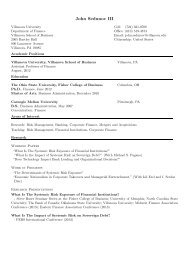A Culture of Collaborative Inquiry: Learning to Develop and Support ...
A Culture of Collaborative Inquiry: Learning to Develop and Support ...
A Culture of Collaborative Inquiry: Learning to Develop and Support ...
You also want an ePaper? Increase the reach of your titles
YUMPU automatically turns print PDFs into web optimized ePapers that Google loves.
Finally, the explicit acceptance <strong>of</strong> collaborative norms allowed SCmembers <strong>to</strong> invoke these when tensions emerged. This agreeduponavenue for dialogue enabled us <strong>to</strong> maintain the inquirystance. Ginny exp<strong>and</strong>ed on this in the context <strong>of</strong> an emergenttension between satisfying grant requirements <strong>and</strong> supportingteachers:I think there‘s this tension between, you know, the desire <strong>to</strong> havethe good work happen in the PLCs <strong>and</strong> the desire <strong>to</strong> make sure thatwe‘re fulfilling the requirements <strong>of</strong> the grant <strong>and</strong> the evalua<strong>to</strong>rs<strong>and</strong> all that, <strong>and</strong> I think that that, sometimes, I don‘t know if thosedifferences will be resolved. I think we just have <strong>to</strong> negotiatethose.Ginny‘s statement that ―we just have <strong>to</strong> negotiate those‖ highlightsthe nature <strong>of</strong> the SC as a learning community. Not all groups feelconcern about the beliefs <strong>of</strong> other members. The growth <strong>of</strong> groupsmay stall when members realize that they hold differing visions <strong>of</strong>or values for the work; that is a point when the group may shift <strong>to</strong> acollection <strong>of</strong> experts working <strong>to</strong> get a job done. Consulting witheach other, or even rejecting the ideas <strong>of</strong> another, may be moretypical than the assumption <strong>of</strong> an inquiry stance. Yet the SCcontinued <strong>to</strong> return <strong>to</strong> negotiation <strong>and</strong> collaborative inquiry evenwhen faced with the pressures <strong>of</strong> time <strong>and</strong> change. As John said,we have collectively ―learned <strong>to</strong> appreciate the importance <strong>of</strong>setting norms. Especially when you‘re going <strong>to</strong> try <strong>to</strong> do deep worklike this.‖ This underst<strong>and</strong>ing shaped the activities <strong>and</strong> resourcesthat we brought <strong>to</strong> the lead teachers during summer academies <strong>and</strong>ongoing meetings.AREAS OF ONGOING KNOWLEDGE NEGOTIATIONThree constructs emerged from the data as critical, ongoing areas<strong>of</strong> negotiation <strong>and</strong> growth: the development <strong>of</strong> a shared vision, theexternal <strong>and</strong> internal constraints <strong>to</strong> communication between SCmeetings, <strong>and</strong> the challenges <strong>of</strong> shared leadership.Negotiating a Shared VisionAlthough developing a shared vision <strong>of</strong> both transformativepr<strong>of</strong>essional development <strong>and</strong> high-quality learning <strong>and</strong> teachingwere explicitly addressed <strong>and</strong> implicitly emerged in many SCconversations, the data show that it was not something that camequickly or easily. Each new challenge, especially those associatedwith facilitating teachers‘ PLCs, presented another indication thatthere were multiple views held. In her interview, Ginny stated,I think that, like any group, there have been times when we‘vebeen . . . surprised that we‘re each coming at it from a differentdirection, that maybe we assumed that we all had this shared idea<strong>and</strong> then at some point it surfaced that we didn‘t have a sharedidea.Alina also talked about this in her interview:This whole notion <strong>of</strong> . . . how does one facilitate a group <strong>and</strong> whatis high-quality teaching <strong>and</strong> learning in mathematics <strong>and</strong> science? Ithink each <strong>of</strong> us has a slightly different view, <strong>and</strong> sometimes evenmore than slightly . . . but we‘re getting a better underst<strong>and</strong>ing <strong>of</strong>what each person thinks as we go along.Using facilita<strong>to</strong>r-developed PLC case studies <strong>and</strong> analyzing datasuch as PLC meeting notes <strong>and</strong> quarterly reports, the SCsimultaneously engaged in negotiating visions <strong>of</strong> high-qualitypr<strong>of</strong>essional development, <strong>and</strong> mathematics <strong>and</strong> science teaching<strong>and</strong> learning. For example, in December 2005, each facilita<strong>to</strong>rbrought PLC meeting notes <strong>and</strong>, in small groups, SC membersused these <strong>to</strong> determine what characterizes a high-functioningPLC. The ensuing discussion surfaced common ideas; however,16 | P a g e




